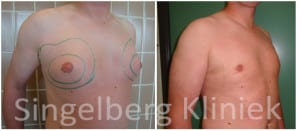Male Chest Reduction – Gynaecomastia
Gynaecomastia is a medical term that comes from the Greek words for “women-like breasts.” Though this oddly named condition is rarely talked about, it’s actually quite common. It may affect only one breast or both. Though certain drugs and medical problems have been linked with male breast overdevelopment, there is no known cause in the vast majority of cases. For men who feel self-conscious about their appearance, male breast reduction surgery can help. The procedure removes fat and/or glandular tissue, and in extreme cases removes excess skin, resulting in a chest that is flatter, firmer, and better contoured. In some instances, surgery may be discouraged for overweight men who have not first tried an exercise and diet regimen.
Procedure
Male breast/chest reduction surgery is usually performed under a general anaesthetic or under a twilight (sedation) . If excess glandular tissue is the primary cause of the breast enlargement, it will be excised, or cut out, with a scalpel.
The excision may be performed alone or in conjunction with liposuction. In a typical procedure, an incision is made in an inconspicuous location–usually on the edge of the areola. Working through the incision, the surgeon cuts away the excess glandular tissue, fat and skin from around the areola and from the sides and bottom of the breast.
Major reductions that involve the removal of a significant amount of tissue and skin may require larger incisions that result in more conspicuous scars. If liposuction is used to remove excess fat,the cannula is usually inserted through the existing incisions. If your gynecomastia consists primarily of excessive fatty tissue, your surgeon will likely use liposuction to remove the excess fat. A small incision, less than a half-inch in length, is made around the edge of the areola–the dark skin that surrounds the nipple. Or, the incision may be placed in the underarm area. A slim hollow tube called a cannula which is attached to a vacuum pump, is then inserted into the incision. Using strong, deliberate strokes, the surgeon moves the cannula through the layers beneath the skin, breaking up the fat and suctioning it out. Patients may feel a vibration or some friction during the procedure, but generally no pain.
In extreme cases where large amounts of fat or glandular tissue have been removed, skin may not adjust well to the new smaller breast contour. In these cases, excess skin may have to be removed to allow the removing skin to firmly re-adjust to the new breast contour. Sometimes, a small drain is inserted through a separate incision to draw off excess fluids.
Once closed, the incisions are usually covered with a dressing. The chest may be wrapped to keep the skin firmly in place.
Conclusions
Surgery to correct gynaecomastia can be performed on healthy men of any age. The best candidates for surgery have firm, elastic skin that will reshape to the body’s new contours.
Surgery may be discouraged for obese men, or for overweight men who have not first attempted to correct the problem with exercise or weight loss. Also, individuals who drink alcohol beverages in excess or smoke marijuana are usually not considered good candidates for surgery. These drugs, along with anabolic steroids, may cause gynecomastia. Therefore, patients are first directed to stop the use of these drugs to see if the breast fullness will diminish before surgery is considered an option.
